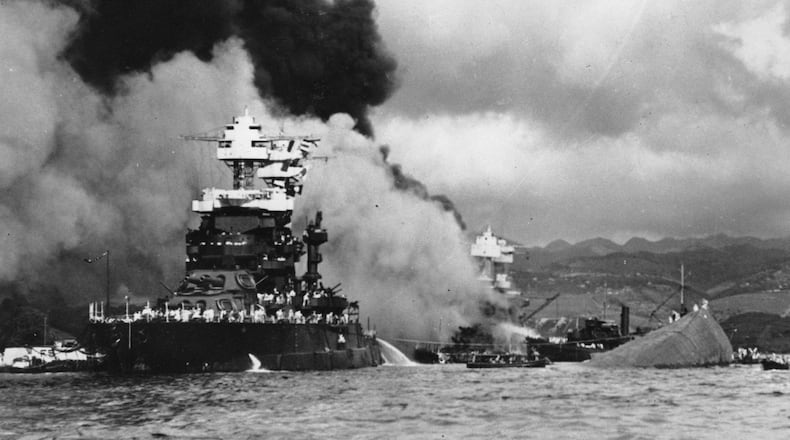Ann Remers was just eight when her father disappeared 77 years ago at Pearl Harbor. She remembers him, Julian B. Jordan, as a kind man who lost his mother at a young age, as a baseball fan, and as a go-getter who graduated from the U.S. Naval Academy.
Jordan, from Dawson in southwestern Georgia, was a Navy lieutenant assigned to the battleship U.S.S. Oklahoma, serving below deck as an engineer. He was 37 the day the Japanese launched their surprise attack, an assault that killed more than 2,400 U.S. troops, damaged or destroyed more than a dozen naval ships and triggered America’s entry into World War II. Torpedoed, the Oklahoma quickly capsized. Jordan and 428 fellow crewmen were lost.
The Navy retrieved their remains after the attack, but was unable to identify Jordan and many others, eventually classifying them as “nonrecoverable.” That was until two years ago, when the government finally announced it had identified his remains using advanced DNA technology and dental records.
The government is still working to account for about 200 other Oklahoma crewmen. In May, the Defense POW/MIA Accounting Agency announced it had identified the remains of another Georgian who served with Jordan on the Oklahoma: Navy Shipfitter 3rd Class John M. Donald, 28, of Ball Ground, located in north Cherokee County.
Remers is grateful for the government’s efforts, though she underscored the decades that have passed and the pressure family members and federal lawmakers have applied to urge the government to finish identifying the remains of the Oklahoma crewmen. Her father was buried with military honors two years ago in Washington, where
he was once stationed.
“Finally, 75 years later, they came through for us and they gave us a very nice service,” said Remers, 85, a retired attorney living in Tucson, Ariz. “They were very helpful. We couldn’t really ask for much more.”
The identification process is painstaking. Following the attack on Pearl Harbor, Navy personnel recovered the remains of the Oklahoma crewmen and interred them in two cemeteries in Hawaii. In 1947, the government transferred them to a laboratory, where 35 Oklahoma crewmen’s remains were identified. The others who could still not be identified were buried at the National Memorial Cemetery of the Pacific in Honolulu.
Military cemeteries and museums in Georgia
In 2015, the Pentagon ordered another investigation. And government scientists using DNA analysis linked Jordan to three cousins. Donald was linked to a niece and a grandniece. The scientists are now using DNA samples – cheek swabs – submitted by surviving relatives.
“Some of these remains we have had for a number of years. We just now have the technology and the family reference samples to be able to make a match,” said Sgt. 1st Class Kristen Duus, a spokeswoman for the Defense POW/MIA Accounting Agency. “We are still identifying service members from the Vietnam War. And we have missions going on all around the world, year-round.”
Some relatives get heavily involved in the process. Among them is Bob Valley of Escanaba, Mich. A member of a group calling itself U.S.S. Oklahoma Family, Valley spent years pushing the government to retrieve the crew’s remains and make another effort to identify them.
In January, the government announced it had accounted for his older brother, Navy Fireman 2nd Class Lowell E. Valley, 19, of Ontonagon, Mich. He was stationed in a part of the Oklahoma that took the brunt of the torpedo attack, his younger brother said.
“It has taken a long time to get the OKs to bring them all up and identify them,” said Valley, 85, a retired accountant. “I have been in contact with everybody in the Pentagon and the president of the United States.”
Valley’s brother was buried this year in Ontonagon. The military, local police and volunteer motorcyclists escorted his remains to a sun-splashed funeral. A radio station reported on the proceedings. People lined the streets, waving American flags and taking pictures.
“It was quite an affair,” Valley said.
Valley’s work to be sure the Oklahoma’s crew was identified was noted in the eulogy for Lieutenant Julian Jordan of Dawson.
Jordan’s grandson, Jay Remers of Cheyenne, Wyo., described his grandfather’s funeral, held on a sunny, warm day in August 2016. A Navy chaplain led the prayers. Remers delivered a eulogy, thanking Bob Valley for his efforts. There was a gun salute. A female vocalist sang the Navy Hymn.
“The Navy, to my surprise, presented us with three folded flags,” Remers said in an email. “My mother naturally received the flag that draped her father’s casket. My sister and I were each presented a folded burial flag as well.”
Jordan’s grave site sits atop a hill overlooking much of the cemetery in Bremerton, Wash., where he was once stationed. Many other World War II veterans are buried nearby, mostly men who died in recent years. His family is planning to visit him this Christmas.
About the Author
The Latest
Featured





